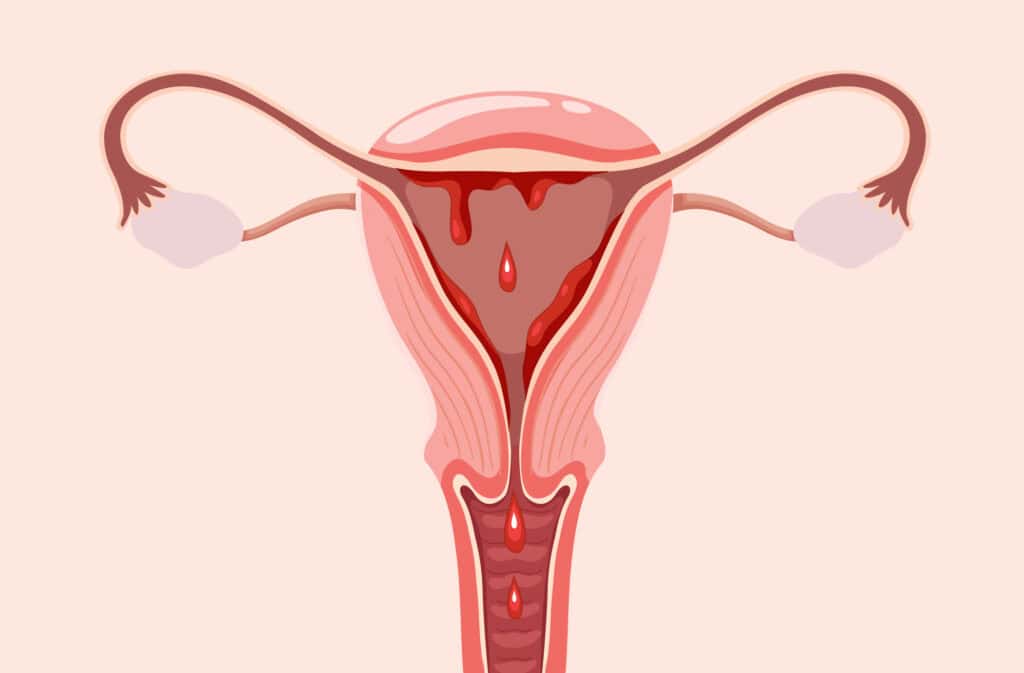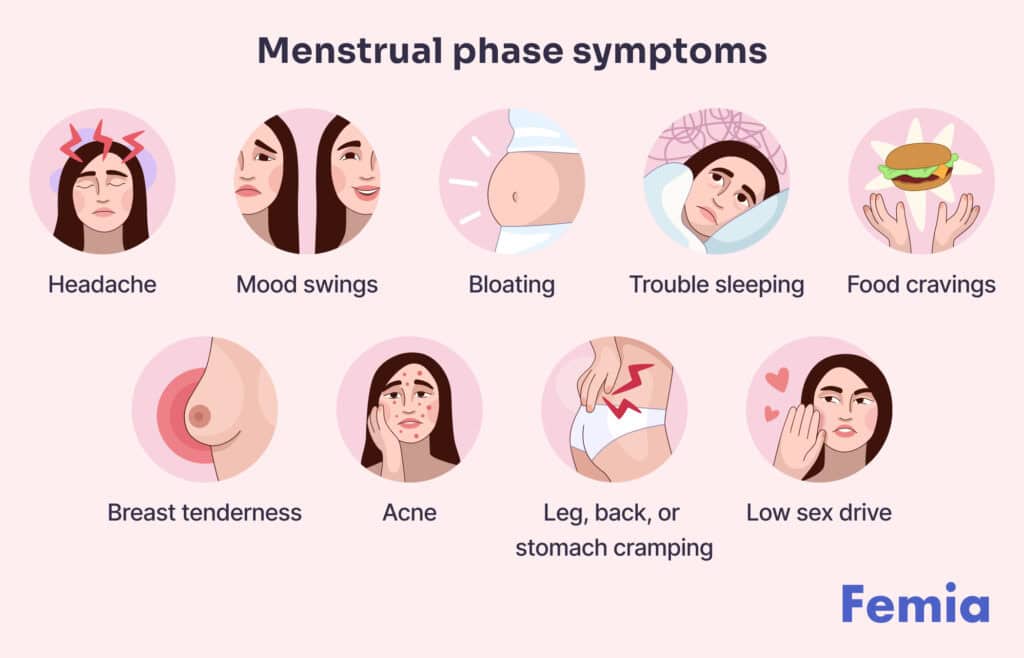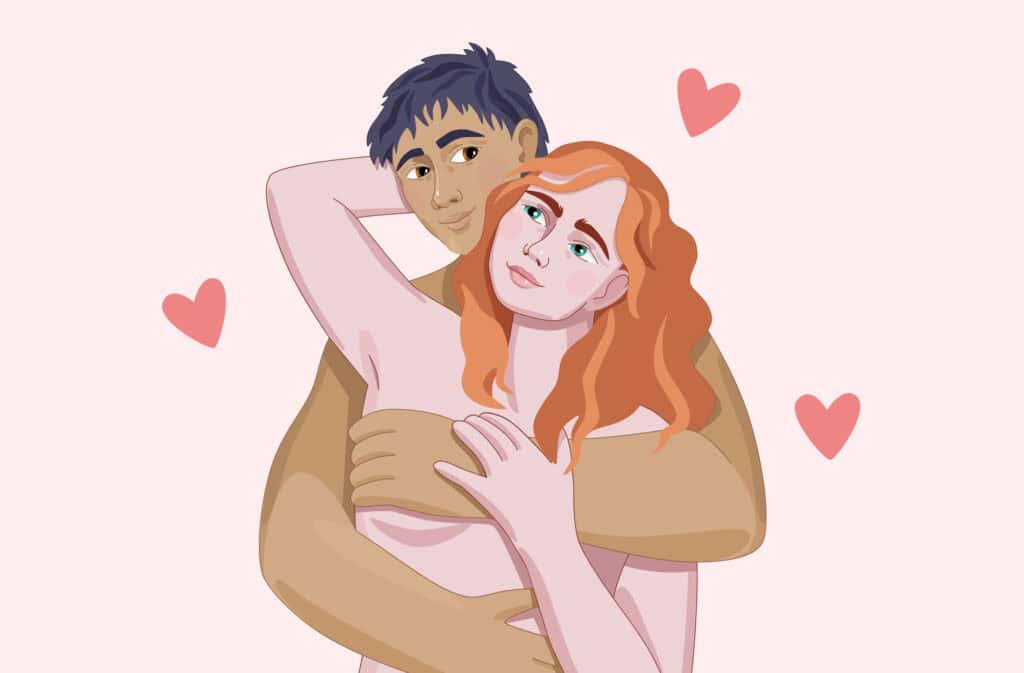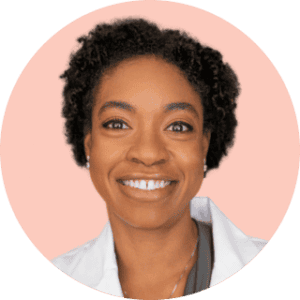Femia > Health Library > Your cycle > Health > Understanding the menstrual phase: Symptoms, foods, and workouts to support your body
Understanding the menstrual phase: Symptoms, foods, and workouts to support your body

- Updated Feb 10, 2025
- Published
CRAFTED BY HUMAN
Crafted by human At Femia, we provide accurate and up-to-date information at every stage of your journey, from trying to conceive, pregnancy and postnatal support. All content is created by a real person based on in-depth research and own professional experience. Femia ensures that you will receive expert advice, strict accuracy and a personalized approach from our authors/medical experts. Learn more about our editorial policy.
FACT CHECKED
Fact checked At Femia Health, we maintain the highest standards of editorial excellence in delivering content focused on helping you conceive, guiding you through pregnancy, and supporting you postpartum. Explore our content review principles to learn how we ensure the accuracy and quality of our health and lifestyle tips for every stage of your journey.
The menstrual phase is the time of the month when your body sheds the uterine lining and blood comes out of your vagina. You might experience symptoms like muscle cramps, mood swings, cravings, or headaches. The best approach to this phase is taking things slow. Practice listening to your body and supporting it through lifestyle changes. Get enough sleep, rest, and exercise – doing low-impact activities like yoga or walking. Eat iron- and magnesium-rich foods to make up for the iron blood loss and reduce muscle cramps.
Menstruation, or period, is normal vaginal bleeding that happens during a woman’s menstrual cycle. In fact, the menstrual phase is the first phase of the menstrual cycle. As you probably know, that time of the month is marked by not only bleeding but also other symptoms like cramps and moodiness.
Menstrual symptoms occur due to hormonal shifts in your body, which can feel pretty intense. The menstrual phase is probably the most delicate phase of the menstrual cycle, as your body works hard to shed and renew the uterine lining. How can you ease through it? Take a deep breath and a moment to rest. After all, it only takes a few days and you’ll be ready to hit the gym again.
Femia helps you understand your symptoms and when to take action
What is the menstrual phase?
The entire menstrual cycle is a series of changes your body goes through each month to prepare for a possible pregnancy. The way your body adapts reflects a complex interplay of sex hormones, which dictate the four phases of the menstrual cycle.
But, what is the menstrual phase? The menstrual phase, also known as the menses, is the first phase of the menstrual cycle. For the sake of this explanation, we will first briefly introduce the other phases.
- Follicular phase: Estrogen and follicle stimulating hormone (FSH) levels start to increase. Follicles in your ovaries grow, while the uterus lining thickens.
- Ovulation: An increase in luteinizing hormone (LH) levels causes the release of the egg from the follicle – a process also known as ovulation. Estrogen levels also peak around this time, before dropping in the next phase.
- Luteal phase: After ovulation, the remaining follicle transforms into a structure called the corpus luteum, which produces progesterone. Progesterone helps thicken the uterine lining further, in case a fertilized egg gets implanted. If this doesn’t happen, progesterone levels decrease.
This brings us to the menstrual phase, which actually marks the beginning of the new cycle (Day 0). Before menses, the uterus lining is as thick as it gets. As the hormone levels drop, the lining cannot be maintained and starts to shed in chunks and pieces, along with the newly formed blood vessels, which results in menstrual bleeding.
The menstrual phase typically lasts between 3 and 5 days, but some ladies only bleed for 1 day, while others may normally menstruate for up to 8 days. Either is fine. Your period may present as light spotting or really heavy flow, with an average blood loss of 30 ml.
👉Find out more: Does period sex make you more attached? Exploring the emotional and spiritual aspects
Menstrual phase symptoms: What to expect

The key sign of the menstrual phase is – believe it or not – bleeding from the vagina. However, there are other menstrual phase symptoms. Here are the most common – and completely normal – symptoms and signs:
- Breast tenderness
- Leg, back, or stomach cramping
- Mood swings
- Food cravings
- Bloating
- Trouble sleeping
- Headache
- Acne
- Low sex drive
Most of these symptoms happen due to the changes in hormone levels – and especially the sudden drop of progesterone and estrogen. Some women may experience very intense symptoms, while for others, it may feel like any other day of the month.
@femia.fertility If you struggle with food cravings during PMS and want to eat more than you need, save these tips to help you manage the situation. #cravings #pregnancycravings #pmscravings #ttc #periodtok #pmssymptoms #pregnancysymptoms #healthynutrition ♬ original sound - Femia fertility app
Cycle syncing menstrual phase: How to adapt your lifestyle
Cycle syncing is a method of tailoring your diet, exercise, and lifestyle habits to the four phases of the menstrual cycle: menstrual, follicular, ovulatory, and luteal. The idea is that by adjusting your activities to the hormonal shifts that occur during each phase, you can have more energy, reduce menstrual symptoms, and improve your overall well-being.
Because of the drop in hormones, you may feel more tired, experience mood fluctuations, or have physical symptoms like cramps, bloating, and back pain during the menstrual phase.
How to make cycle syncing menstrual phase specific? The body is in a state of natural recovery, so it’s a good time for rest and self-care. Focus on light activity and eating nutritious foods.
👉Find out more: Why is my period blood black? Causes, meanings, and when to seek help
What to eat during menstrual phase: Supporting your body
If you are wondering what to eat during menstrual phase, just think of what happens to your body during menstruation. Menstrual phase foods should replenish the iron lost through bleeding, as well as help with muscle cramps.
Iron-rich foods
Eating the following foods rich in iron might help you feel more energized during your period.
- Spinach. This leafy green is packed with iron and magnesium.
- Lentils. An excellent plant-based source of iron, protein, and fiber.
- Chickpeas. Rich in both iron and protein, they can be added to soups, salads, or stews.
- Quinoa. This whole grain provides a good amount of iron and is a great source of complete protein (which contains all the amino acids your body needs but can’t make on its own).
- Pumpkin seeds. A great snack high in iron and other essential nutrients.
- Red meat. If you eat meat, now is the time to have some. Red meat like beef and lamb is an excellent source of heme iron, which is the iron form that is easily absorbed by the body.
Magnesium-rich foods
Incorporating these nutrient-dense foods into your meals can help ease cramps during your menstrual phase.
- Almonds. They’re packed with magnesium, healthy fats, and fiber, making them great for managing cramps.
- Pumpkin seeds. In addition to iron, they’re high in magnesium, which helps relax muscles.
- Dark chocolate. Choose dark chocolate with 70% cocoa or higher for a good source of magnesium and an indulgent treat.
- Avocados. Full of healthy fats and magnesium, they can reduce bloating and support muscle relaxation.
- Bananas. Rich in magnesium and potassium, they can help with muscle function and reduce cramping.
- Black beans. A versatile and magnesium-rich legume that also provides iron.
Anti-inflammatory foods and teas
Consuming more foods that reduce inflammation can reduce bloating and discomfort during this sensitive time.
- Ginger. Known for its anti-inflammatory and pain-relieving properties, ginger can help ease cramps and reduce bloating. Add it to soups, smoothies, or tea.
- Turmeric. This powerful anti-inflammatory spice contains curcumin, which can help reduce menstrual pain and inflammation.
- Chamomile tea. With natural anti-inflammatory properties, chamomile can help calm the body, reduce cramps, and improve sleep.
- Peppermint tea. Helps to soothe bloating and relieve digestive discomfort during menstruation.
Menstrual phase workout: What exercises to do
Your menstrual phase workout should be adjusted to your overall energy levels during menstruation. The best piece of advice we could give you is to always listen to your body. Don’t push too hard during the more intense days.
- Walking. Taking a walk is a gentle, low-impact way to stay active without putting too much strain on the body. Walking increases circulation, helps reduce bloating, and can ease cramps.
- Gentle yoga. Try poses such as Child’s Pose, Cat-Cow, and Reclined Butterfly to relieve cramps, relax tense muscles, and promote deep breathing. Restorative or yin yoga styles are especially calming during menstruation.
- Light stretching. Stretching can help alleviate muscle tension, particularly in the lower back and hips. Gentle stretches targeting the hip flexors, hamstrings, and lower back may ease cramping and improve flexibility.
- Pilates. Low-impact Pilates routines focus on core strength and flexibility without draining your body. Choose slow, controlled movements that don’t involve intense activity.
Can a woman get pregnant during menstruation?
What does science say: can a woman get pregnant during menstruation? You’ve probably heard that it is not possible to get pregnant while on your period. Are periods risk-free zones for those not wanting to get pregnant?
Although the chances of getting pregnant remain significantly lower during your period, pregnancy can still happen. Remember, the egg is viable for approximately 24 hours after ovulation, and sperm can survive for 3 to 5 days in your body after ejaculation. Some women ovulate early on in their cycle (as opposed to the regular mid-cycle ovulation), making it possible for the egg to get fertilized if any remaining sperm has endured.
If your cycle is irregular or you have an underlying gynecological condition like endometriosis, it will be even more difficult to predict your fertility window. So, your preferred contraception method(s) is a good idea if you are not looking to get pregnant.
👉Find out more: Can you get pregnant on your period? Understanding the odds and timing
When to worry: Looking for alarming signs
Your menstrual cycle, and especially the period, reflects your hormonal balance and the overall health of your body. Certain symptoms and signs can indicate underlying health conditions, and sometimes you might need to seek immediate medical care.
- Losing a lot of blood. If you feel like you are bleeding more than usual, make sure to talk with a trusted healthcare provider as soon as possible. Soaking through one or more pads or tampons every hour for several consecutive hours or passing large blood clots is considered abnormal bleeding (also known as menorrhagia). Blood loss over 80 ml is not supposed to happen.
- Severe pain. A lot of women experience menstrual cramps, but the intensity varies from person to person and period to period. If the pain does not improve with over-the-counter pain medications or makes you skip usual daily activities, it might be a good idea to seek medical attention. Severe pain during periods, also known as dysmenorrhea, could be a sign of conditions like endometriosis or fibroids.
- Unusual discharge or odor. Periods don’t smell great, but take note of any odor that is out of the ordinary. An odd smell accompanied by itching, pain, or irritation may be a sign of an infection such as bacterial vaginosis or a sexually transmitted infection (STI).
- Extreme fatigue or dizziness. A bit of tiredness is to be expected, but feeling unusually weak, tired, or dizzy during menstruation could be a sign of anemia, especially if you are losing a lot of blood.
- Irregular periods. Drastic changes in cycle length, missing periods (when not pregnant), or periods that come too frequently could indicate hormonal imbalances or other health issues that your healthcare provider might want to investigate further.
Questions from Femia community
Why do I feel more tired during my period?
Feeling more tired during your period is common due to hormonal fluctuations, blood loss, and physical discomfort. As estrogen and progesterone levels drop, it can lead to fatigue, while the loss of iron through menstruation can also lower energy levels. Sleep disturbances from cramps or discomfort, along with emotional stress, can further contribute to feeling exhausted. Staying hydrated, eating iron-rich foods, and getting enough rest can help you feel better.
Should I avoid caffeine during menstruation?
It's generally a good idea to limit caffeine during menstruation, as it can worsen cramps and bloating for some women by constricting blood vessels and increasing tension in the body. Caffeine can also dehydrate you, which might intensify headaches or other symptoms. Instead, try herbal teas or other non-caffeinated drinks.
What natural remedies for period cramps could I try?
If you are looking for natural ways to relieve period cramps, try using a heating pad or hot water bottle to help relax muscles and ease pain. Eating magnesium-rich foods like leafy greens, nuts, and seeds can also reduce cramping by relaxing muscle tension. Herbal teas, particularly ginger and chamomile, have anti-inflammatory properties that can soothe discomfort and reduce cramps.
The bottom line
The menstrual phase of your cycle is the perfect time to slow down. As your body is regenerating and preparing for the next cycle of changes, you can adjust your lifestyle to support your natural rhythms.
This is the time for self-care and rest. Practice listening to your body and taking care of it. Make sure to get enough sleep, relax, and postpone any intense activities. Consume nutrient-dense food and stay hydrated to make up for the iron loss. If you feel like it, do light workouts, such as yoga or walking, to alleviate symptoms like cramps and fatigue.
References
- Dysmenorrhea. 13 May 2019, https://www.hopkinsmedicine.org/health/conditions-and-diseases/dysmenorrhea.
- “Irregular Periods.” National Health Service (NHS), 24 Oct. 2017, https://www.nhs.uk/conditions/irregular-periods/.
- Menstruation. National Library of Medicine, https://medlineplus.gov/menstruation.html. Accessed 2 Oct. 2024.
- “Period Blood Smell: What You Need to Know.” Medical News Today, 26 July 2019, https://www.medicalnewstoday.com/articles/325878.
- “Periods.” NHS.UK, 19 Oct. 2017, https://www.nhs.uk/conditions/periods/.
- Thiyagarajan, Dhanalakshmi K., et al. “Physiology, Menstrual Cycle.” StatPearls, StatPearls Publishing, 2024, PubMed, http://www.ncbi.nlm.nih.gov/books/NBK500020/.

Learn the crucial differences between period vs miscarriage bleeding. Understand symptoms, timing, and how to distinguish early miscarriage vs period. Expert guidance from Femia.

Learn the signs of a high sex drive in female, factors that influence women libido, and tips on how to manage and embrace your desires for a healthy sexual life.

Prepare for a healthy pregnancy with our ultimate pre-pregnancy checklist. Learn about essential tests, lifestyle adjustments, financial planning, and more to ensure a smooth journey to parenthood.

